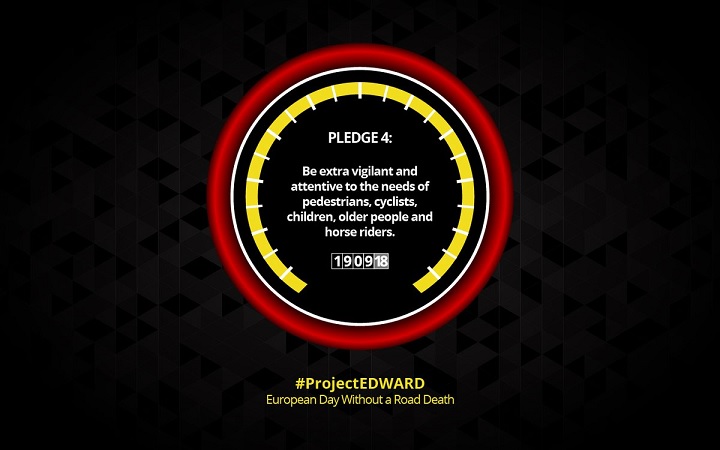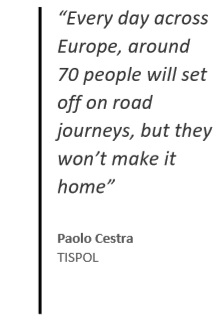
Winning the hearts and minds of individual road users is vital to bringing about sustained and significant reductions in road deaths, says TISPOL ahead of Project EDWARD 2018.
Project EDWARD was created in 2016 by TISPOL, the European Traffic Police Network, to ‘re-energise the reduction of fatalities and serious injuries on Europe’s roads’.
TISPOL’s long-term aim is to use Project EDWARD to spearhead significant and sustained reduction in death and serious injury on roads across the world.
Project EDWARD 2018, which takes place on 19 September, was launched in June – with the target of reaching more than 50 million social media users.
 Last month, TISPOL published a new Project EDWARD resource library, with materials to help road safety officers promote and share key messages.
Last month, TISPOL published a new Project EDWARD resource library, with materials to help road safety officers promote and share key messages.
Between 11-19 September, TISPOL representatives will undertake an ‘ambitious’ #ProjectEDWARD road trip – visiting venues in the UK, Ireland, France, Belgium, the Netherlands, Germany, Luxembourg and Spain.
The trip is designed to boost the profile of safety on Europe’s roads and to support the work carried out by roads policing officers across the continent.
On Project EDWARD day itself, TISPOL will join representatives of the European Transport Safety Council (ETSC), the Guardia Civil and a line-up of sponsors and supporters at a conference to be held in Madrid.
The event will include a 60-minute interactive broadcast featuring a round-up of the day’s activity around Europe, interviews and other features, live-streamed via Twitter.
Paolo Cestra, TISPOL president, said: “Every day across Europe, around 70 people will set off on road journeys, but they won’t make it home. That means 70 families will receive a knock at the door with the life-shattering news that they have lost a loved one in what was most likely an entirely preventable crash.
“We do not want that to happen to any family, and we will do everything we can to reduce the toll of road fatalities.
“But we need to gain the support of individual road users, and we know that if everyone is prepared to reflect on the risks they face and the risks they may pose to others, then we can have safer drivers, safer road users and safer journeys.
“Please think about the way you drive, ride or cross the road. Think about how you can reduce risk by always wearing a seatbelt, keeping to speeds that are both legal and appropriate for the conditions, not driving after drinking alcohol or taking drugs, and not using a mobile phone at the wheel.”
Sorry, Richard, I see such comment as being characteristic of people who analyse from behind a desk. The close following scenario is basically easy to analyse. If a driver can not stop in time if things go pear-shaped in front, then they have been following too closely and contravening HC126. It is widely accepted that if a vehicle is less than two seconds away from the one in front it almost certainly would not be able to stop in time, and if it is around one second away then that can reasonably be described as in suicide mode. So you don’t need detailed statistics of this road or that road, this vehicle or that one etc. If they are less than two seconds away they are vulnerable. Many travel at around one second so, if anyone can not define that as close following (with the associated vulnerability to crashes) please let me know.
Nigel ALBRIGHT
0
Absolutely, Bob. But isn’t it interesting that something which is really such a vital part of being safe on the road seems to generate far less interest than, for example, the detailed discussion on the KSIs in 20mph zones. Not to say that is not important in it’s way but, in the scale of things, that seems to me far less so than something which will potentially have a far wider effect on safety on the roads generally and nationally. So we will see what comes out of the Sept 17th (today’s) promotional drive. No pun intended.
Nigel ALBRIGHT
0
The problem is that tailgating is a driver’s subjective opinion and no scientific research has actually been carried to define it and measure its occurance on different types of road.
MR RICHARD T WALKER, london
0
I would obviously have liked it if they also said that they, the police would be looking for drivers to not only keep to speed limits and not to use unnecessary and inappropriate speeds BUT also to maintain a definite clear safe following on distances from the vehicle in front as well
I understand that Highways England will be promoting safety and in particular the effects of rear end Shunts. [Tailgating ]. This will commencing on the 17th September and go on for 6 weeks until the end of October. They will be doing their own thing on an intervention that recognises and warns drivers of the lack of safe space between vehicles. What a refreshing change….. I will look forward to that one.
R.Craven
+1